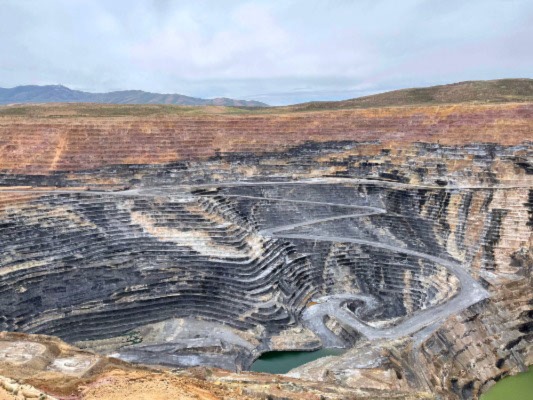
The lab, funded by the Kleinman Center for Energy Policy in the Stuart Weitzman School of Design, and the School of Engineering and Applied Science, focuses on carbon management techniques like carbon capture and the technologies to expand such processes. Psarras is interim director while Jennifer Wilcox is on leave to work in the Biden Administration’s Department of Energy.
This team sees great environmental potential in mine tailings, the sand and sludge left behind after the sought-after ore gets removed. With samples in the lab, they’re trying to determine just how much calcium and magnesium each contains, how to best carbonate it with CO2, how and where they can store the result, and whether the process is scalable. So far, they’ve partnered with five mines, but there’s plenty more material out there; the United States generates enough mine tailings in a year to fill 38 million Olympic-size swimming pools.
The vastness of the mines
Without physically traveling to one of these open-pit mines, it’s hard to imagine their size. “They are absolutely huge, vast,” says Katherine Vaz Gomes, a third-year doctoral student in the CECL. “It’s really the place where industry meets the Earth, literally and figuratively.” Picture a hole in the ground 10 or 20 times larger than a football stadium, Psarras adds.
He and Gomes say experiencing a mine in production engages the senses in unexpected ways. Perspective is skewed; rock-hauling trucks with wheels that tower over any person’s head appear as dots on the horizon. In the plant, the noise level only allows for communication by yelling. Everything smells like dust—even through the protective gear required at the mines, Gomes says. “You don’t think that dust has a smell but it’s actually pungent,” she says. “Your shoes get covered in it, too.”
Though these mining operations have figured out how to simplify something quite complex, the process itself still produces a significant amount of leftover material, with large sections of rock formations ultimately being dubbed waste. Such mine tailings, also known as gangue material, are stored separately from the mining production, sometimes as far away as a mile. They can be mixed with water and turned into a mud slurry, then moved via a large pipe and stored in a giant pool, or they might get dumped onto and transported by a massive conveyer belt.
“Imagine excavating a mountain, then building basically an entire new mountain of just waste nearby,” Psarras says. “We’re trying to tap into the moved mountain that’s been relocated.” Like the mines themselves, the scale here is immense, hundreds of feet deep to receive something like a million tons of waste each month for the lifetime of the mine.
Psarras says it’s easy to feel both overwhelmed by the mines and awestruck at the people who run them. “They have everything so fine-tuned,” he says. “I always go back to the lab inspired, but also with the understanding that we can’t complicate their process when we introduce another element of complexity with our technology.”
This story is by Michele Berger. Read more about ‘Mine Tailings’ at Penn Today.
